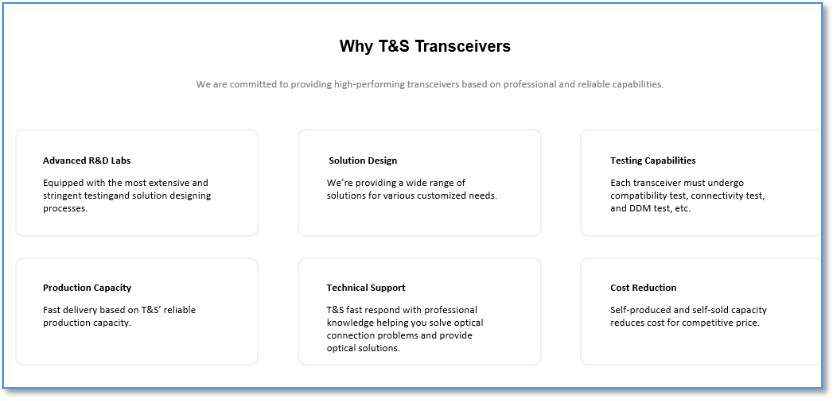At T&S, we supply a wide range of fiber optical transceivers for network, server and storage systems. Optical transceiver we supply are fully compatible with original manufacturer hardware. All products are subject to in-depth qualification and testing to ensure that it will perform the demands of live technology environments. All our transceivers are manufactured using the highest quality components and covered by comprehensive warranty. Our fiber optical transceivers are compliant with Ethernet, Fibre Channel, Infiniband, SONET/SDH/OTN, CPRI, OIF, and PON standards and operate at data rates up to 400 Gbps. They are capable of distances ranging from very short reach within a datacenter to campus, access, metro, and long-haul reaches, by utilizing a broad portfolio of internally designed and fabricated optical components such as 850 nm VCSELs, DFB lasers etc. T&S provides high-quality fiber optical transceivers, delivering exceptional data transmission, reliability, and performance for diverse networking applications.
Common Types of Fiber Optical Transceivers
1. XFP
XFP is among the earliest transceiver types. XFP is still widely used in spite of the fact that it is extremely difficult to find new equipment that supports this transceiver type. Ethernet, and SONET connections at 10Gbps are supported by XFP optical transceivers.
But because it supports high-density multiplexing, this type of transceiver typically functions with fiber the best. The fact that XFP uses so little power makes it very energy efficient.
2. SFP
The most popular format for optical transceivers is SFP, which allows for hotswapping and pluggable transceivers. They do have some restrictions even though they are frequently used. SFP transceivers, on the other hand, function well with high-density ports and have a top speed of up to 5Gbps.
SFP transceivers, however, are typically used for connections up to 1Gbps. SFP transceivers support a variety of different wiring types, including single-mode fber, Ethernet, multimode fber, and SONET.
3. SFP+
SFP+transceivers such as sfp+ sr transceiver are frequently chosen by users who enjoy SFP transceivers but desire a more dependable and swifter device. A newer and better version of the original SFP optical transceivers are these transceivers. Higher data transfer rates are supported by an SFP+ transceiver than with SFP. Additionally, the transmission speeds have greatly increased due to SFP+ transceivers' ability to transmit data at up to 10Gbps over an Ethernet connection.
4. QSFP and QSFP+
Quad (4-channel) small form-factor pluggable is referred to by the abbreviation QSFP. Data communications applications also use this small, hot-pluggable transceiver. According to SFF-8436, the QSFP+ standard has evolved to support 10Gb/s data rates. When compared to QSFP+, QSFP products support Quarter Small Form-factor Pluggable with a different data rate, meaning that the product solution is unaffected. Nowadays, QSFP+ gradually replaces QSFP and is widely used by people due to its ability to provide higher bandwidth.
5. QSFP28
A high-speed, high-density item created for 100Gbps applications is the 100G QSFP28 transceiver module. Its form factor is the same as that of QSFP+ transceivers. With four channels of high-speed differential signals with data rates ranging from 25 Gbps to potentially 40 Gbps, QSFP28 100G optics can finally meet the requirements for 100 Gbps Ethernet (4x 25 Gbps) and 100 Gbps 4X InfiniBand Enhanced Data Rate (EDR). The 100GBASE-SR4, 100GBASE-LR4, 100GbASE-PSM4, and 100GBASE-CWDM4 standards are currently available for the QSFP28 transceiver. Over a 100m multimode fiber, QSFP28-100G-SR4 can be used. A much greater distance of 10km is supported by 100GBASE-LR4 QSFP28. The market for 100G optics is more popular with QSFP28 form factors than CFP form factors.
6. CFP
CFP, or C form-factor pluggable, is an agreement among multiple sources to create a standard form-factor for the transmission of high-speed digital signals. Since the standard was primarily created for 100 Gigabit Ethernet systems, the "c" stands for the Latin letter C used to express the number 100 (centum). It supports 40 and 100Gb/s applications, including 40G and 100G Ethernet, OC-768/STM-256, OTU3, and OTU4.
Fiber Optical Transceivers Application
In wired networking applications like Ethernet, Fibre ChannelSONET/SDH/ONT, CPRl, FTTx, and infiniBand, fiber optic transceivers are frequently used. The platform consists of Ethernet switches, routers, firewalls, network interface cards, and fiber media converters.
These fiberoptic transceivers are used by storage interface cards, also known as HBAs or Fibre Channel storage switches, for a variety of speeds, including 2Gb, 4Gb, 8Gb, and 16Gb.
The current high-speed optical transceiver application scenarios are mainly Internet data center networks, metropolitan area network optical transmission networks, and telecommunication networks represented by 5G bearer networks.
T&S Fiber Optical Transceivers Advantages
Advanced R&D Labs: Equipped with the most extensive and stringent testing and solution designing processes.
Solution Design: We're providing a wide range of solutions for various customized needs.
Testing Capabilities: Each transceiver must undergo compatibility test, connectivity test, and DDM test, etc.
Production Capacity: Fast delivery based on T&S' reliable production capacity.
Technical Support: T&S fast respond with professional knowledge helping you solve optical connection problems and provide optical solutions.
Cost Reduction: Self-produced and self-sold capacity reduces cost for competitive price.


 中文
中文 EN
EN
 jp
jp  fr
fr  es
es  it
it  ru
ru  pt
pt  ar
ar  el
el  nl
nl 






























 Call us on:
Call us on:  Email Us:
Email Us:  8 Jinxiu Middle Road,
8 Jinxiu Middle Road, 